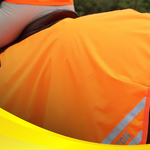
How to Know When It’s Time to Blanket Your Horse
As the temperatures drop and winter weather sets in, many horse owners start asking the same question: “Should I blanket my horse yet?”
The answer isn’t always simple — because the right time to blanket depends on more than just the temperature. Factors like coat type, living conditions, age, and even your horse’s workload all play a role.
Here are some helpful tips to guide you in deciding when (and what) to blanket your horse this season.
1. Watch the Weather — Not Just the Thermometer
Cold alone doesn’t always mean it’s time to blanket. Horses are naturally good at keeping warm when it’s cold but dry.
It’s when wind, rain, or snow enter the picture that they can start losing body heat faster than they can produce it.
- Dry & Calm (Above 40°F): Most unclipped horses are fine without a blanket.
- Wet or Windy (Below 45°F): Even horses with thick coats can get chilled.
- Freezing (Below 32°F): Most horses appreciate at least a lightweight or medium blanket, especially if turned out overnight.
Tip: A waterproof turnout blanket helps prevent body heat loss on those cold, damp days — even if it’s not snowing.
2. Consider Coat Type and Clipping
A horse’s natural winter coat is an incredible insulator, but clipping changes everything.
- Clipped Horses: They lose their natural insulation, so they need blanketing once the temps dip below about 50°F (lighter blankets at first, then heavier as temps drop).
- Unclipped Horses: Their coat provides warmth, but they still need protection from rain, snow, or freezing winds.
- Partially Clipped Horses: Match your blanket to the area clipped — a trace or blanket clip might need only a medium weight.
3. Age, Body Condition, and Health Matter
Older horses, those who are underweight, or horses recovering from illness may struggle to regulate body temperature.
If your senior horse starts losing weight as soon as the cold hits, adding a blanket can help conserve calories and keep them comfortable.
4. Think About Where Your Horse Lives
Environment makes a big difference!
- Pasture Horses: Horses living outdoors 24/7 need waterproof turnout blankets for rain and snow, and possibly heavier fills in harsh winter climates.
- Stalled Horses: Stable blankets or stable sheets work well indoors where it’s dry but still cool.
- Horses with Shelter: A sturdy run-in shed can help reduce the need for heavy blanketing by providing natural protection from the elements.
5. Use the “Hands-On” Temperature Test
This simple trick can tell you a lot:
Gently slip your hand under your horse’s blanket (or mane if they’re not wearing one) at the base of the neck or withers.
- If your horse feels cold to the touch, add a layer.
- If they feel warm or sweaty, lighten the blanket.
A quick daily check helps you adjust as temperatures change — which they often do quickly in winter!
6. Layer Smartly
If you’re unsure what weight to use, layering can be your best friend.
Many modern blankets, like WeatherBeeta’s ComFiTec line, use interchangeable liners that make it easy to add or remove warmth without changing the whole blanket.
Start with a lightweight turnout and add a liner when temperatures drop — it’s flexible, convenient, and space-saving.
7. Adjust Often
Blanketing isn’t “set it and forget it.”
Horses’ needs can change day to day with temperature swings, sunlight, and activity level.
- Warmer during sunny days? Drop a layer.
- Cold front overnight? Add a medium or heavy turnout.
- Heading to a show or ride? Swap to a cooler afterward to help them dry comfortably.
Consistency and awareness are key — and your horse will thank you for it.
Stay Warm with Golden Horseshoe Equestrian
Whether your horse needs a lightweight sheet for fall, a waterproof turnout for the pasture, or a cozy stable blanket for overnight, we’ve got you covered.
Shop our collection of WeatherBeeta, Shires, Equinavia, and more — designed to keep every horse warm, dry, and comfortable all winter long.
Prev post

Blanket Weights
Updated on 12 November 2025
Next post

Rider Safety Week Spotlight: Be Seen, Be Safe with Equi-Flector
Updated on 21 September 2025
